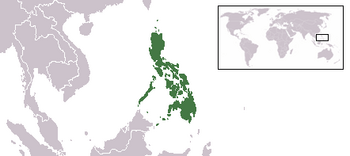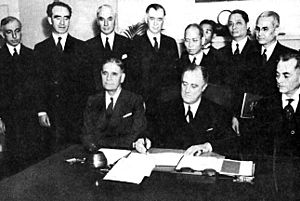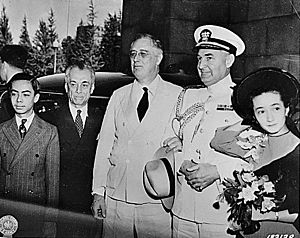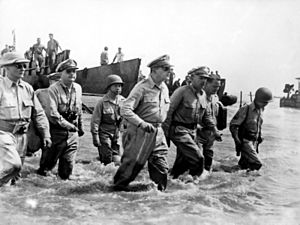Philippine Commonwealth facts for kids
Quick facts for kids
Philippine Commonwealth
|
|||||||||||
|---|---|---|---|---|---|---|---|---|---|---|---|
| 1935-1946 | |||||||||||
|
Flag
|
|||||||||||
|
Anthem: "The Philippine Hymn" (Territorial)
|
|||||||||||

Location of the Philippines in Asia
|
|||||||||||
| Status | Associated state of the United States Commonwealth |
||||||||||
| Capital | Manila¹ | ||||||||||
| Common languages | Spanish, English, and Tagalog | ||||||||||
| Government | Republic | ||||||||||
| President | |||||||||||
|
• 1935-1944
|
Manuel L. Quezon | ||||||||||
|
• 1944-1946
|
Sergio Osmeña | ||||||||||
|
• 1946
|
Manuel Roxas | ||||||||||
| Vice President | |||||||||||
|
• 1935-1944
|
Sergio Osmeña | ||||||||||
|
• 1946
|
Elpidio Quirino | ||||||||||
| Legislature | National Assembly (1935-1941) Congress (1945-1946) |
||||||||||
| Historical era | Interwar period | ||||||||||
|
• Tydings-McDuffie Act
|
November 15, 1935 | ||||||||||
|
• Independence
|
July 4 1946 | ||||||||||
| Area | |||||||||||
| 1939 | 300,000 km2 (120,000 sq mi) | ||||||||||
| Population | |||||||||||
|
• 1939
|
16000303 | ||||||||||
| Currency | Peso | ||||||||||
|
|||||||||||
|
¹ Capital held by enemy forces between December 24, 1941 and February 27, 1945. Temporary capitals Corregidor from December 24, 1941-; Iloilo City from February 22; Bacolod from February 26; Buenos Aires, Bago City from February 27; Oroquieta from March 19; Bukidnon from March 23; Melbourne, Australia from April; Washington, DC from May, 1942 to October, 1944; Tacloban from October 20, 1944.
²In exile. |
|||||||||||
The Philippine Commonwealth was the government of the Philippines from 1935 to 1946. During this time, the Philippines was still under the control of the United States. It was a step towards the Philippines becoming a fully independent country.
The Commonwealth was created by a law called the Tydings-McDuffie Act in 1934. In 1935, Manuel L. Quezon became the first Filipino president of this new government. The President had strong power over the islands. There was also a Supreme Court and a law-making body called the National Assembly.
In 1937, the government chose Tagalog, a language spoken in Manila, as the national language. Women were also given the right to vote, and the economy was doing well.
The Philippine Commonwealth government had to leave the country from 1942 to 1945. This happened when Japan took control of the Philippines during World War II. In 1946, the Commonwealth ended, and the Philippines became fully independent as the Third Philippines Republic.
Contents
How the Government Worked
The Philippine Commonwealth had its own special rulebook, called a constitution. This constitution was used until 1973. The Commonwealth could govern itself, but the United States still handled its foreign policy (how it dealt with other countries) and military matters. Some laws also needed the approval of the American President.
The government had a very strong President. There was a single National Assembly that made laws, and a Supreme Court that decided legal cases. All members of these groups were Filipinos. There was also an elected person who represented the Philippines in the United States House of Representatives.
Americans were also part of the government. There was an American High Commissioner and an American Military Advisor. A Field Marshall was in charge of the Philippine Army. Later, in 1939-1940, the National Assembly was changed into two parts: a Philippine Senate and a House of Representatives.
History of the Commonwealth
Getting Started

Before 1935, the Philippines was ruled by an American governor general. In 1932, the U.S. Congress passed a law called the Hare-Hawes-Cutting Act. This law was meant to give the Philippines independence. However, it also said the U.S. would keep military bases and put taxes on Philippine goods. The Philippine Senate, led by Manuel L. Quezon, did not agree with this law.
Because of this, a new law was made: the Tydings-McDuffie Act. This law allowed the Philippine Commonwealth to be set up. It planned for the Philippines to become fully independent after 10 years. The Commonwealth officially began on November 15, 1935.
Before that, a special meeting was held in Manila in 1934 to write a constitution. This new constitution was approved by U.S. President Franklin D. Roosevelt in March 1935. Filipinos then voted to approve it in May 1935.
In October 1935, elections were held for president. Manuel L. Quezon and Sergio Osmeña from the Nacionalista Party won. Quezon became president and Osmeña became vice-president. The Commonwealth government officially started with a big ceremony in Manila. About 300,000 people attended.
Before World War II
The new government started many big plans to prepare for independence. They worked on national defense, like creating a military draft. They also wanted more control over the economy, improve democracy, and make changes in education and transportation. They also tried to encourage local businesses and develop the island of Mindanao.
However, there were many challenges. People worried about the military situation in Southeast Asia. They also wondered how much the U.S. would help the Philippines in the future. The worldwide economic problem called the Great Depression also caused issues. There were also problems with farmers being unhappy and power struggles between Quezon and Osmeña.
It is hard to say if these plans worked well. This is because Japan invaded and took over the Philippines during World War II.
World War II and Independence
Japan attacked the Philippines on December 8, 1941. The Philippine Army joined the U.S. Army to fight the Japanese. Manila was declared an "open city" to try and save it from damage, but the Japanese still took it over in January 1942. Fighting continued in other areas for several months.
President Quezon and Vice President Osmeña had to leave the Philippines. They went to Australia and then to the U.S. There, they set up a government that continued to work from outside the country. During this time, Quezon became very sick and passed away. Osmeña then became president.
Meanwhile, the Japanese set up a new government in the Philippines called the Second Philippine Republic. However, most Filipinos did not support it.
Many Filipinos continued to fight against the Japanese. Groups like the Hukbalahap (meaning "People's Army Against the Japanese") fought back. Other parts of the Philippine Army also fought using guerrilla warfare. They were very successful, freeing many provinces.
American General Douglas MacArthur and Philippine Commonwealth troops landed in Leyte in October 1944. They were welcomed as heroes. Fighting continued until Japan surrendered in August 1945. Manila was badly damaged during the war.
After the war, the Philippine Commonwealth government was brought back. There was one more year to prepare for full independence. Elections were held in April 1946. Manuel Roxas became the first president of the independent Republic of the Philippines. The Philippines became independent exactly as planned on July 4, 1946.
Important Policies
National Language
The Philippines has many different languages. The 1935 constitution said that a common national language should be developed. The Commonwealth created a "National Language Institute." This group chose Tagalog as the basis for the new "national language," which would be called "Pilipino."
In 1940, the government approved creating a dictionary and grammar book for Pilipino. A law was also passed that made Pilipino an official language when the Philippines became independent.
Economy
The economy of the Commonwealth was mostly based on farming. Farmers grew crops like abaca, coconuts, sugar, and timber. The Philippines also earned money from American army, navy, and air bases, such as the naval base at Subic Bay. The economy was strong until World War II stopped its growth.
Population and Languages
In 1941, about 17 million people lived in the Philippines. Manila had a population of 684,000. There were also many Chinese people (117,000) and Japanese people (30,000). About 27% of the population spoke English, while only 3% spoke Spanish.
Here are some of the most spoken languages at the time:
- Cebuano: 4,620,685 speakers
- Tagalog: 3,068,565 speakers
- Ilocano: 2,353,518 speakers
- Hiligaynon: 1,951,005 speakers
- Waray-Waray: 920,009 speakers
- Kapampangan: 621,455 speakers
- Pangasinan: 573,752 speakers
List of Presidents
| Color Legend | |
|---|---|
| Nacionalista | |
| Liberal | |
The colors show the political party of each President when they were elected.
| # | President | Took office | Left office | Party | Vice President | Term | |
|---|---|---|---|---|---|---|---|
| 1 | Manuel L. Quezon | November 15, 1935 | August 1, 19441 | Nacionalista | Sergio Osmeña | 1 | |
| 2 | |||||||
| 2 | Sergio Osmeña | August 1, 1944 | May 28, 1946 | Nacionalista | vacant | ||
| 3 | Manuel Roxas | May 28, 1946 | July 4, 1946² | Liberal | Elpidio Quirino | 3 | |
1 Died of tuberculosis at Saranac Lake, New York.
² End of Commonwealth government, independent Republic began.
Images for kids
-
President Manuel Luis Quezon of the Philippines
See also
 In Spanish: Mancomunidad Filipina para niños
In Spanish: Mancomunidad Filipina para niños





